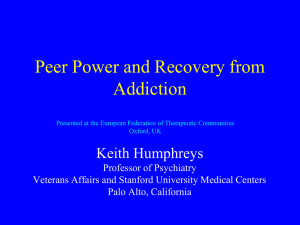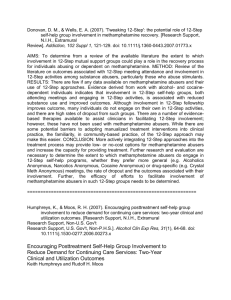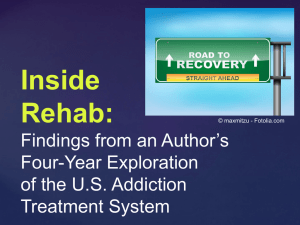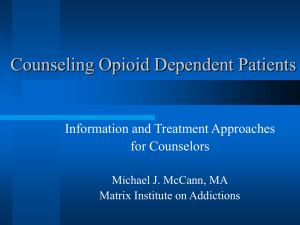IJMA 2 (APA) in press
advertisement
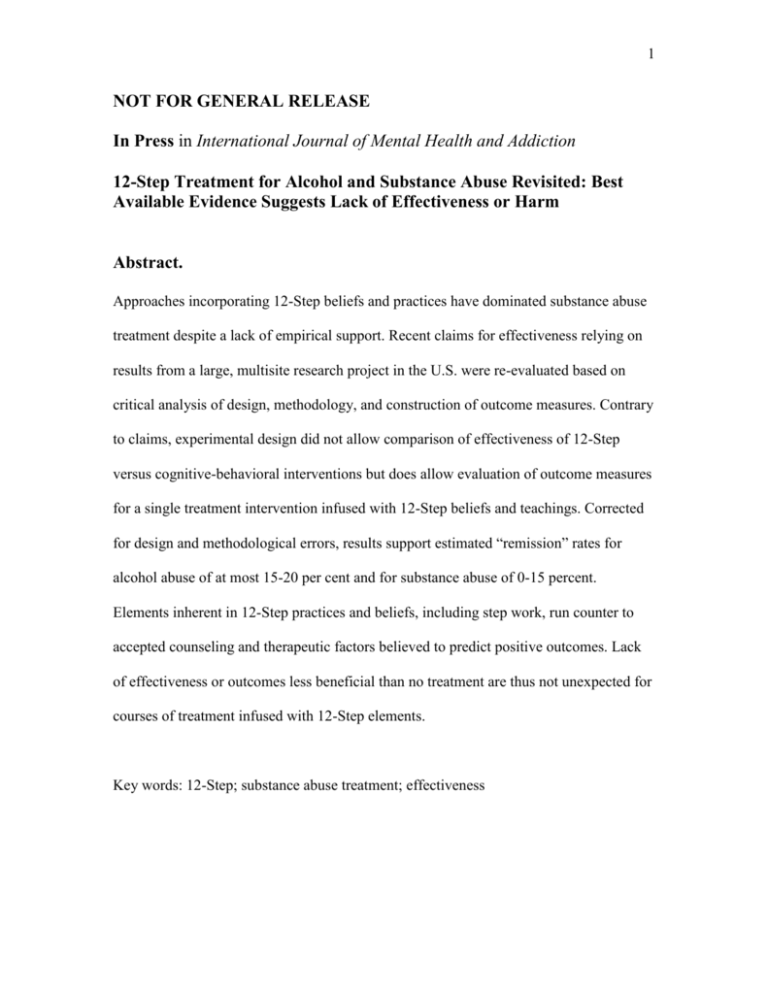
1 NOT FOR GENERAL RELEASE In Press in International Journal of Mental Health and Addiction 12-Step Treatment for Alcohol and Substance Abuse Revisited: Best Available Evidence Suggests Lack of Effectiveness or Harm Abstract. Approaches incorporating 12-Step beliefs and practices have dominated substance abuse treatment despite a lack of empirical support. Recent claims for effectiveness relying on results from a large, multisite research project in the U.S. were re-evaluated based on critical analysis of design, methodology, and construction of outcome measures. Contrary to claims, experimental design did not allow comparison of effectiveness of 12-Step versus cognitive-behavioral interventions but does allow evaluation of outcome measures for a single treatment intervention infused with 12-Step beliefs and teachings. Corrected for design and methodological errors, results support estimated “remission” rates for alcohol abuse of at most 15-20 per cent and for substance abuse of 0-15 percent. Elements inherent in 12-Step practices and beliefs, including step work, run counter to accepted counseling and therapeutic factors believed to predict positive outcomes. Lack of effectiveness or outcomes less beneficial than no treatment are thus not unexpected for courses of treatment infused with 12-Step elements. Key words: 12-Step; substance abuse treatment; effectiveness 2 12-Step Treatment for Alcohol and Substance Abuse Revisited: Best Available Evidence Suggests Lack of Effectiveness or Harm INTRODUCTION Given the scope of worldwide public health problems related to substance use disorders, it is critical that choice of interventions be informed by sound, empirically based evaluation. Despite decades of dominance of approaches based on 12-Step principles, there have been no rigorously controlled research designs comparing 12-Step treatment outcomes to no-treatment controls, and a recent review found no gains in outcome for 12-Step interventions over alternative interventions (Ferri, Amato, & Davoli , 2006). Claims for effectiveness of the 12-Step intervention continue to be based on studies lacking a no-treatment control (e.g., Moos, 2003). Currently, assessment of (e.g. Marlatt, Witkiewitz, Dillworth, Bowen, Parks, Macpherson, Lonczak, Larimer, Simpson, Blume, & Crutcher, 2004) and claims of effectiveness for (e.g. Moos, 2003; Moos, Finney, Ouimette, & Suchinsky, 1999; Morgenstern, Blanchard, Morgan, Labouvie & Hayaki, 2001) 12-Step interventions rely on a group of published reports generated from a study of patients who entered U.S. Department of Veterans Affairs (VA) substance abuse treatment programs and participated in a multisite study. Although as in other studies of 12-step interventions there was no control for comparison to no treatment, a number of features (Moos et al., 1999) establish the study as the most powerful evaluation to date of effectiveness of 12-Step based intervention for substance abuse: large (intake n = 3699) sample size, replication across 15 sites, and a naturalistic design drawing data from real clinical settings. 3 Here, results and conclusions reported from this study are re-evaluated based on a critical analysis of design, methodology and construction of outcome measures using published reports (Finney, Noyes, Coutts, & Moos, 1998; Ouimette, Finney & Moos, 1997; Ouimette, Moos, & Finney, 1998) along with clarifying information and assessment instruments provided by the researchers (R.H. Moos, personal communication). RESULTS The research project is described by Ouimette et al. (1997) and elsewhere, and was an attempt to evaluate the effectiveness of prevalent treatment modalities for substance abuse. The authors grouped treatment programs at 15 different VA facilities across the U.S. into three research groups: 12-Step, cognitive-behavioral (C-B) and mixed. Assessment occurred at intake and at 1 year post-treatment for outcome measures including abstinence (alcohol), substance abuse (illicit drugs), anxiety, depression, employment, and other measures of functioning. Quantitative scales were used for outcome variables, and a variety of statistical tests used to analyze results for statistical significance. Overall, there were statistically significant improvements in functioning at 1-year follow-up compared to admission. In addition to the main hypothesis of differences in outcome due to treatment type, the authors hypothesized differences due to these factors: fidelity to treatment type, completion of treatment, presence of cooccurring disorders, and whether treatment was mandated. No such differences were detected. 4 To assess effectiveness of “substance abuse treatment”, the authors constructed the outcome measures, among others, of “remission” and “abstinent”. Both included the conditions of lack of problems resulting from alcohol or other drug use and “no illicit drug use”. In addition, “abstinent” included the condition of no alcohol consumption while “remission” of no more than three ounces of ethanol per day. Thus “remission” was used to indicate success at a non-abstinent treatment goal of use of alcohol without significant impairment in functioning. The researchers concluded that overall the treatments studied resulted in a 25 percent remission rate for substance abuse at one-year follow up (p. 237 of Ouimette et al., 1997). Design of Treatment Types Although the study was intended to evaluate any differences in effectiveness of 12-Step versus C-B treatment interventions, it becomes clear that the design does not allow such evaluation. As indicated (Table 1 of Ouimette et al., 1997), and not surprisingly (Quinn, Bodenhamer-Davis & Koch, 2004), staff delivering treatment in the nominal C-B programs at VA treatment centers endorsed 12-Step beliefs and goals, although to a lesser degree than did staff in the 12-Step programs. Accordingly, subjects in the C-B treatment groups, receiving treatment from clinical staff invested in 12-Step beliefs and goals, engaged in “step work” – the key, intensive inculcating element in the 12-Step program – at essentially the same level (average of six steps completed) as in the 12-Step group (see Table 1 of Finney et al., 1998). Some of the step work had been completed prior to the treatments, but the statistically significant increase over the course of treatment shows that on average, subjects in the C-B treatments completed an average of 1.3 steps during the treatment episode, compared to 1.8 steps for subjects in the 12- 5 step groups. In addition to completing step work, subjects in the 21 – 28 day C-B treatment episodes attended an average of 7.4 12-Step meetings, gained associations with “12-Step friends”, and read 12-Step materials, all statistically significant increases from pre-treatment assessment (Table 1 of Finney et al., 1998). At the end of the episodes, 12 percent of C-B subjects had 12-Step sponsors. A sponsor in the 12-Step tradition is an advisor and teacher in 12-Step beliefs, and in this study sponsors would have had some interaction with subjects presumably in addition to time that was quantified as time allocated to C-B versus 12-Step treatment activities. Consistent with these substantial 12-Step activities engaged in by subjects in the nominal C-B treatment groups, the C-B subjects showed no decrease in alcoholic identity over the course of treatment and only a slight decrease in disease model beliefs (Finney et al., 1998). Other cognitions central to the 12-Step program such as powerlessness, moral culpability, and external versus internal locus of control were not assessed. Completion of the first six steps inculcates subjects in the 12-Step concepts of powerlessness, moral culpability, and the external efficacy of a magical power or force, all concepts external to cognitive-behavioral therapy. In the nominal C-B programs one hour of 12-Step programming occurred for every 10 hours of C-B elements (apparently excluding time spent interacting with sponsors). By way of analogy, imagine a hypothetical research design to evaluate effectiveness of couple therapy interventions, nominally structural family therapy or choice therapy. Imagine that for each hour of therapy true to the practice theory being evaluated, six minutes are spent by the therapist conveying to the couple concepts not congruent with the intervention being evaluated: e.g. that they are powerless over the conflicts in their relationship, that the source of 6 strength and solutions in their relationship is a “higher power” they should rely on, and that one partner’s role is to avoid conflicts with and comply with the decisions of a designated decision-making partner. Infused with extraneous and discordant conceptual elements, this design could not constitute a legitimate evaluation of the effectiveness of the nominal practice theory. Additionally, while the initial (or “index”) research treatment episodes were 21or 28-day, they were followed by 11 months of aftercare prior to measurement of outcome (Ouimette et al., 1997), and we can infer characteristics of the aftercare experiences from information provided in a companion paper (Ouimette et al., 1998). All subjects were referred to outpatient aftercare treatment and to 12-Step participation, and a large majority (80%) complied. Aftercare which subjects took part in included 12-Step meetings and outpatient treatment at VA facilities. As described above, and as could be predicted based on the dominance of 12-Step based practice and staffing in addiction treatment programs in the US (Quinn et al., 2004), the VA programs were infused with 12-Step goals and activities and staffed by individuals invested in 12-Step beliefs. In short, in this naturalistic design there was no intact cognitive-behavioral treatment group, but instead, a single experimental group consisting of 21- or 28-day initial episodes including C-B elements, infused with 12-Step goals and activities, delivered by staff invested in 12-Step beliefs, followed by up to 11months of outpatient treatment infused with 12-Step elements. While outcomes may be attributed to client experiences of the single experimental treatment regime thus accurately described, clearly there was no scientifically valid evaluation of C-B versus 12-Step approaches. 7 Again, an analogy may illustrate the seriousness of this flaw. Imagine a hypothetical drug trial comparing psychotropics A and C, which have antagonistic proximal pathways, administered to treatment groups for 28 days each, followed by referral to an 11-month regime of pharmacological treatment which includes some unmonitored and unquantified dosage of A and C. Imagine further that in each nominal initial 28-day regime of A versus C, subjects in fact receive both A and C. Clearly this design would not support attribution of outcomes at 1 year to hypothesized differences in effectiveness of medications A versus C. Self reports of Outcome Another design element not fully accounted for stems from relying on self reports for measures of substance abuse. The study demonstrated a rate of false positive outcome reports (i.e. of subjects reporting no use of a substance then testing positive by urine analysis) of at least 5 percent (alcohol) to 14 percent (illicit drugs), and this was for subjects functional enough to make and keep medical appointments. We must assume that a one-time, non-random biological test is likely to significantly underestimate abuse of alcohol or illicit drugs and therefore to underestimate such false positive outcome selfreports. If we, perhaps conservatively, postulate a combined rate of false self reports of (1) no alcohol abuse, of (2) no use of illicit drugs, and of (3) no problems due to substance abuse (all included in the constructed outcome measure of “remission”) at 20 percent, the success rate for remission due to the intervention must be lowered accordingly from the claimed rate of 25 percent. Selection Bias 8 Another apparent source of error was the removal of a large subset (681 of 3699 subjects) from the data set which would have likely overwhelmingly been measured as not in remission. These were 86 subjects who were in good enough health to complete the initial treatment episodes but then died prior to the 1-year follow-up, along with 595 subjects who were experiencing significant enough problems in functioning to either refuse to disclose 1-year status or to be unable to be located. If, of the 3018 subjects who were high functioning enough and willing and able to complete the 1-year follow-up assessment, only 25 percent met criteria for “remission”, then it seems reasonable to postulate that of the 86 who died and the 595 who were low functioning, as described, percentage meeting criteria for remission would likely be nearer to zero. Accounting for this error and the rates of false self reports would almost certainly reduce the claimed remission rate of 25 percent to a range of 15 to 20 percent, at best. Construction of Outcome Measures The most consequential element, however, is the study’s arbitrary construction of outcome measures. The implicit rationale for the inclusion of the condition of “no illicit drug use” in the construction of outcome measures is both intuitive and clinically based persons receiving treatment for addiction problems often remain addicted to abuse of substances, with harmful effects, by substituting one addictive substance for another. On this rationale, treatment for “substance abuse” cannot be considered successful based solely on the discontinued use of an addictive substance if the outcome of treatment is the continued harmful abuse of a another addictive substance or substitution of the harmful, addictive use of one substance for another. 9 In restricting their construction of continued or substituted addiction to “illicit” drugs, the authors have predetermined false positive outcomes for the certain cases of continued use or substitution of addictive substances or activities as harmful as or more harmful than some of the illicit drugs included, but which are not “illicit”. Two that come immediately to mind are food and nicotine, the latter arguably the costliest known addictive substance for public health in our culture. Abuse of either of these substances causes early mortality and other serious health effects, and is constructed as a psychiatric disorder. Those familiar with the 12-Step recovery community are aware that abuse of these potentially lethal substances is common among 12-Step participants who are nonetheless constructed by Alcoholics Anonymous and others as “clean and sober” and successfully treated (i.e., an individual compulsively using food or nicotine with associated morbidity and labeled “sober” was measured in the VA study as a successful outcome of substance abuse treatment). This arbitrary construction – correctly identifying addictive use of harmful “illicit” substances as lack of positive outcome, yet normalizing and failing to operationalize use of equally harmful or more harmful substances commonly abused by 12-Step participants – would significantly and falsely inflate “positive” outcomes Once the methodological and conceptual errors discussed above are accounted for, a reasonable estimate can be postulated for the single treatment type evaluated in this study (individual and group counseling delivered by staff invested in 12-Step beliefs, completion of step work, and attendance at 12-Step meetings, combined with cognitive behavioral elements), beginning with the claimed outcome for “remission” of approximately 25 percent. Factoring in the errors discussed above, we would confidently 10 expect an actual remission rate for “substance abuse” of no more than 0 percent to 15 percent, which may be no greater than or less than for no treatment (i.e., the experiential and motivational import of psychosocial factors surrounding a detoxification and inpatient admission for alcoholism itself may well result in 10 to 20 percent remission at 1-year follow up without any form of treatment). In short, if we begin with the authors’ reasonable rationale for construction of outcome measures of substance abuse treatment, then apply that rationale in a way that is consistent as well as clinically and ethically supportable, we are led to conclude, using data from this study, that the single treatment design evaluated (one year of step work and 12-Step meeting attendance, with an initial 21- or 28-day period including some components of cognitive-behavioral treatment) is, in the best case, ineffective. DISCUSSION While the result that treatment programs infused with 12-Step principles appear at best ineffective, and possibly harmful, as interventions for alcohol or substance abuse will be vigorously contested, it was in fact predictable based on the counter-therapeutic nature of key elements of the 12 –step approach (Le, Ingvarson & Page., 1995; Quinn et al., 2004). Therapeutic alliance (e.g. Kohlenberg, Kanter, Bolling, Wexner, Parker & Tsai, 2004) and unconditional positive regard are considered important and primary predictors of positive therapeutic outcome; yet 12-Step approaches utilize and instill moral culpability, deviance and labeling. In contrast to the therapeutic factors of enhanced self-efficacy (e.g. Bandura, 1982; Miller and Rollnick, 1991) and internal versus external locus of control (Borkovec & Sharpless, 2004), the 12-Step approach inculcates participants with a sense of powerlessness and dependence on an external force 11 for change. The disease model of addiction, central to the 12-Step approach, pathologizes individual clients, and in doing so distracts attention and efforts from social and intrapsychic stressors that may underlie addictive impulses. At the same time, the disease concept provides clients an escape from personal responsibility for choices (e.g. the client in treatment for alcohol dependence, who upon beginning participation in AA began repeatedly asserting, “It’s not Tony, it’s the disease.” to explain his history of spouse battering.). There is a large body of anecdotal reports and uncontrolled studies offered as evidence for therapeutic value of 12-Step based activities. Individuals who stop use of a harmful substance while concurrently engaging in 12-Step related activities often become highly invested in attributing behavioral change to those activities and beliefs, apart from internal motivation and self efficacy. Certainly there are collateral components of 12-Step related experiences, not necessarily related to the principles and beliefs themselves, which may provide therapeutic value. The program is often available, without charge, to anyone willing to engage in it, congruent with unconditional regard. In many contexts, such as AA and NA meetings, there is the planned absence of an authority figure or expert directing interventions, which may promote self efficacy. 12-Step activities are often delivered in group modality, which may have therapeutic values inherent to the group experience (e.g. Yalom, 1995). Normalization of distress in a group of peers, for example, is believed to have therapeutic value, as may the instillation of hope associated with social learning – observing behavioral change in others with similar impairments. What seems critical for clients with substance use problems is that researchers, professionals, and institutions distinguish among therapeutic efficacy of various 12 elements, essential versus collateral to 12-Step, so that positive treatment outcomes can be maximized. Members of Alcoholics Anonymous identify and reward success in terms of abstinence from alcohol. In doing so, they normalize potentially equally harmful substitute addictions, in effect doing harm by depriving individuals of motivation to address the harmful behaviors and the underlying problems in managing emotional distress. There appears to be no clinical, logical, theoretical, or ethical justification for excluding these harmful addictions from outcome measures in addiction treatment studies. Interestingly, this arbitrary construction of outcome measures does align well with the moralistic element of 12-Step philosophy – use of substances which are “illegal” (= morally deviant), such as heroin, LSD or cannabis, is measured as a failed outcome of substance abuse treatment, while simultaneously the significant negative effects of nicotine dependence or of obesity due to compulsive use of food (which are not prohibited and therefore not morally deviant) are normalized and measured as successful outcomes of treatment. The exclusion of harmful use of nicotine in research designs, mental heath diagnoses, and intervention programs, along with related cultural, socioeconomic and ideological questions, is itself worthy of analysis and evaluation. Potential lines of consideration include the absence, until relatively recent attention on effects of secondary exposure, of demonstrable risk of harm apart from that to users, and the potential negative impact on outcome success of treatment programs if nicotine use were to be factored in. 13 It might be argued that the 12-Step approach functions covertly, despite its focus on abstinence, as a form of harm reduction, helping some individuals move from alcoholism or a polysubstance use problem to harmful use of nicotine (or food) only. Support for reduction of harm, however, would appear to require more thorough evaluation of rates of substitution among 12-Step participants including changes in severity of use of the substituted substance and associated morbidity and collateral effects. It would be important to include heretofore unevaluated psychosocial issues familiar to professionals working with families, such as potential cognitive impacts, through social learning and modeling, on children exposed to 12-Step culture in which parents are affirmed as “clean and sober” while continuing harmful use of an addictive substance. Finally, recent theoretical and empirical work has emphasized the importance of the concept of experiential avoidance in maintaining psychological distress and promoting relapse (Hayes, Follette, & Linehan., 2004). The 12-Step program is structured to provide avoidance of here-and-now inner experience. The structure and ritual of 12Step group experience inhibits openness, interaction, and spontaneity; and the pastcentered storytelling and step work provide emotional and cognitive distance from immediate experience. Conceivably, it could be argued that the apparent lack of effectiveness for the mixed intervention is due to inclusion of cognitive-behavioral elements, i.e. that if not for the inclusion of cognitive-behavioral interventions, the 12-Step based activities would have resulted in much higher rates of positive outcomes. However, a number of considerations argue strongly against this conclusion: (1) anecdotal claims for 14 effectiveness of 12-Step based treatment typically acknowledge successful outcomes no greater than in the area of 20 percent remission, (2) widely tested cognitive-behavioral interventions and techniques for a variety of psychiatric disorders often provide positive outcomes in the range of 60 percent and greater (e.g., Orsillo, Roemer, Lerner & Tull, 2004), and (3) most significantly, as discussed above factors which theory and research identify as being counter-therapeutic are central to the 12-Step approach but apparently not to cognitive-behavioral interventions. The limitations of self reports and potentially even of collateral verification are common to many designs. Related issues worthy of continued deliberations include: the potential effects on accuracy of self report of shaming, confrontational or pathologizing versus motivational approaches; the role of trust and therapeutic alliance; and harm reduction versus abstinence as treatment goals. Another potentially confounding factor in the study examined and in treatment policy concerns residential versus outpatient environments as related to elements of structure, intensity, compliance, motivation, internal versus external locus of control, and covert coercion. For example, while clients in the VA study were aware of participating in a study and were provided intensive services in a residential setting, individuals voluntarily accessing 12-Step programs through self help groups reportedly have very high rates of attrition. It does seem remarkable that an approach infused with known counter-therapeutic factors and with no demonstrated evidence for effectiveness could dominate substance abuse practice, even be routinely mandated for involuntary clients by the state (i.e. by courts and other elements of the criminal justice system). This may be partly understandable in terms of ideological, economic and other factors (Peele, 1998; Quinn et 15 al., 2004) which have resulted in a culture of substance abuse treatment in the United States dominated and to some extent controlled by adherents of the disease model and of the 12-Step program, a culture which can be hostile to non-adherents, to scrutiny, and to change (Quinn et al., 2004). CONCLUSIONS As predicted from counter-therapeutic elements central to 12-Step programs, best available empirical evidence, corrected for methodological errors, suggests that treatment infused with 12-Step practices and beliefs results in outcomes for alcohol abuse and for substance abuse which are at best ineffective and possibly less beneficial than no treatment. Along with ineffective treatment of substance use disorders, the programs appear to reinforce counter-therapeutic cognitions and behaviors. Studies which allow conclusions regarding the effectiveness of 12-Step based interventions are rare. Peele’s (e.g., 1998) critiques of Project MATCH highlight design deficits (subject filtering biased toward positive outcomes, no control group, lack of fidelity to realistic clinical settings) which limit allowable interpretations. In the metaanalysis by Miller, Brown, Simpson, Handmaker, Bien, Luckie, Montgomery, Hester & Tonigan (1995), 12-Step based interventions could not be reliably ranked in efficacy compared to other treatments. A community survey of treated versus untreated alcoholics in the U.S. (Dawson, 1996) found that percentage assessed as relapsing to abuse or dependence was actually higher in the treated group, although differences between groups in other variables again limit allowable interpretations. As in the studies cited 16 above, a more recent meta-analysis (Ferri et al., 2006) did not allow conclusions supporting 12-Step involvement as not different from or less harmful than no treatment. In this context, the VA study analyzed here is significant for its realistic clinical settings, replication across sites, and subject pool with less initial filtering than in Project MATCH. The corrected outcome results (likely 0 to 15 percent remission for substance abuse) support the conclusion that the type of realistic community 12-Step based intervention described is at best ineffective and likely less beneficial than no treatment. As applied to practice, these results appear to obligate professionals in the helping fields, on the principle of nonmaleficence, at the least to avoid referring clients to 12-Step-based treatment programs. Under the principle of informed consent, professionals appear obligated to inform prospective clients that empirically based research suggests that 12-Step based treatment for abuse of alcohol or other substances is at best ineffective. Promising established (e.g. Miller and Rollnick, 1991) and emerging (Hayes et al., 2004) interventions exist for substance use disorders. Results presented here call on researchers and treatment providers to tolerate the frustration and uncertainty of change in order to create and evaluate new integrations of motivational, cognitive-behavioral and emerging interventions that may promote effective change and relief for clients. Most importantly, a less constrained appraisal of models and outcomes of treatment, constructions of pathology, ideological forces, and of etiology may allow a productive refocus on longstanding suggestions for a fundamentally psychosocial understanding (Gustavsson, 1991; Humphreys & Rappaport, 1993; Peele, 1998; Quinn et al., 2004) of addictive behaviors. 17 Acknowledgments Dr. Heather Vonderfecht provided comments on early drafts of this article. References Bandura, A. (1982). Self-efficacy mechanism in human agency. American Psychologist, 37, 122-147. Borkovec, T. D. & Sharpless, B. (2004). Generalized anxiety disorder: Bringing cognitive-behavioral therapy into the valued present. In S. C. Hayes, Follette, V. M. &: Linehan, M. M. (Eds.), Mindfulness and acceptance (pp. 96-119). New York: Guilford Press. Dawson, D. A. (1996). Correlates of past-year status among treated and untreated persons with former alcohol dependence: United States, 1992. Alcoholism: Clinical and Experimental Research, 20, 771-779. Ferri, M., Amato, L., & Davoli, M. (2006). Alcoholics Anonymous and other 12-step programmes for alcohol dependence. Cochrane Database of Systematic Reviews, Issue 3. Art. No.: CD005032. DOI: 10.1002/14651858.CD005032.pub2. Finney, J. W., Noyes, C. A., Coutts, A. I. & Moos, R. H. (1998). Evaluating substance abuse treatment process models: I changes on proximal outcome variables during 12-step and cognitive-behavioral treatment. . Journal of Studies on Alcohol, 59, 371-380. 18 Gustavsson, N.S. (1991). The war metaphor: a threat to vulnerable populations. Social Work, 36, 277-278. Hayes, S. C., Follette, V. M. & Linehan, M. M. (Eds.) (2004). Mindfulness and acceptance. New York: Guilford Press. Humphreys, K. & Rappaport, J. (1993). From the community mental health movement to the war on drugs. American Psychologist, 48, 892-901. Kohlenberg, R. J., Kanter, J. W., Bolling, M., Wexner, R., Parker, C. & Tsai, M. (2004). Functional analytic psychotherapy, cognitive therapy and acceptance. In S. C. Hayes, Follette, V. M. &: Linehan, M. M. (Eds.), Mindfulness and acceptance (pp. 96-119). New York: Guilford Press. Le, C., Ingvarson, E. P. & Page, R. (1995). Alcoholics anonymous and the counseling profession: Philosophies in conflict. Journal of Counseling & Development, 73, 603-610. Marlatt, G. A., Witkiewitz, K., Dillworth, T. M., Bowen, S. W., Parks, G. A., Macpherson, L. M., Lonczak, H. S., Larimer, M. E., Simpson, T., Blume, A. W., & Crutcher, R. (2004). Vipassana meditation as a treatment for alcohol and drug use disorders. In S. C. Hayes, Follette, V. M. &: Linehan, M. M. (Eds.), Mindfulness and acceptance (pp. 261-287). New York: Guilford Press. Miller, W. R. & Rollnick, S.(1991). Motivational interviewing: Preparing people to change addictive behavior. New York: Guilford Press. Miller, W.R., Brown, J.M., Simpson, T.L., Handmaker, N.S., Bien, T.H., Luckie, L.F., Montgomery, H.A., Hester, R.K., and Tonigan, J.S. (1995). What works?: A methodological analysis of the alcohol treatment outcome literature. In R.K. 19 Hester and W.R. Miller (Eds.), Handbook of alcoholism treatment approaches (2nd Ed., pp. 12-44). Boston: Allyn and Bacon. Moos, R. H. (2003). Addictive disorders in context: Principles and puzzles of effective treatment and recovery. Psychology of Addictive Behaviors, 17, 3-12. Moos, R. H., Finney, J. W. Ouimette, P. C. & Suchinsky, R. T. (1999). A comparative evaluation of substance abuse treatment: I. Treatment orientation, amount of care, and 1-year outcomes. Alcoholism: Clinical and Experimental Research, 23, 529536. Morgenstern, J., Blanchard, K. A., Morgan, T. J., Labouvie, E. & Hayaki, J. (2001). Testing the effectiveness of cognitive-behavioral treatment for substance abuse in a community setting: Within treatment and posttreatment findings. Journal of Consulting and Clinical Psychology, 6, 1007-1017. Orsillo, S. M., Roemer, L., Lerner, J. B. & Tull, M. (2004). Acceptance, mindfulness and cognitive-behavioral therapy: Comparisons, contrasts, and application to anxiety. In S. C. Hayes, Follette, V. M. &: Linehan, M. M. (Eds.), Mindfulness and acceptance (pp. 261-287). New York: Guilford Press. Ouimette, P. C., Finney, J.W. & Moos, R.H. (1997). Twelve-step and cognitivebehavioral treatment for substance abuse: a comparison of treatment effectiveness. Journal of Consulting and Clinical Psychology, 65, 230-240. 20 Ouimette, P. C., Moos, R. H. & Finney, J. W. (1998). .Influence of outpatient treatment and 12-step involvement on one-year substance abuse treatment outcomes. Journal of Studies on Alcohol, 59, 513-522. Peele, S. (1998). Ten radical things NIAAA research shows about alcoholism. The Addictions Newsletter, 5, 6; 17-19. Quinn, J. F., Bodenhamer-Davis, E. & Koch, D. S. (2004). Ideology and the stagnation of AODA treatment modalities in America. Deviant Behavior, 25, 109-131. Yalom, I. (1995). The theory and practice of group psychotherapy (4th ed.). New York: Basic Books.

